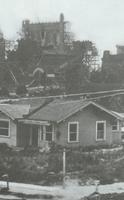Hollywood Babylon, Part 3
 Hollywood used to be a dirty town. Like Times Square in New York it had its share of crazy homeless people, thieving junkies, punk and hookers. But just as that time passed for Times Square, so does it seem to be passing for Hollywood.
Hollywood used to be a dirty town. Like Times Square in New York it had its share of crazy homeless people, thieving junkies, punk and hookers. But just as that time passed for Times Square, so does it seem to be passing for Hollywood.
An important part of the Disneyfication of the center of what used to be the film industry is Hollywood and Highland. Definitely part of the Malling of America, this huge structure includes a hotel, a bowling alley, and mind numbing number of chain retail stores you could find anywhere. It's the home to the Kodak Theater, responsible for "moving the Oscars back to Hollywood." (If there ever was a sign of the oozing spread of mediocity, it would have to involve the Oscars.) As an added bonus, it ruined the Chinese Theater.
Built on the site of the Hollywood Hotel, (erected in 1905 and torn down in 1956 -- the first hotel in Hollywood and therefore home to many of the top stars of the budding industry) the area has a storied past. But the recognition of this fact isn't its only nod to history.
Hollywood and Highland resurrected the Babylonian arch from Intolerance (as well as one of the white elephant statues.) And, in an effort to put icing on that cake, the arch frames a fabulous view of the Hollywood Sign (when there isn't much smog, otherwise, it's obscured.)
Who knew that in the new watered down, "safe" Hollywood there would be a remnant of such a fabulous story -- a story of excess, prejudice, dissipation and resurrection, not just of Intolerance itself, but of D.W. Griffith and the industry at large.
Someone should make a movie out of it.
Hollywood and Highland, 6801 Hollywood Blvd., Los Angeles, CA
Crumbling Treasures
 In Los Angeles, we're not much for history. We knock things down. We build them the way we
In Los Angeles, we're not much for history. We knock things down. We build them the way we like them. We believe in creating a world the way we think it should be. It's this ethic that has destroyed some of our more famous landmarks, Pickfair (the first home in Beverly Hills) was dismantled by Pia Zadora, the original Brown Derby may, at the time of this writing, be a dry cleaner. In a place where people come to reinvent themselves no one has much time for old stuff.
This is, however, not entirely the case with the Ennis Brown House. Built in 1924 by Frank Lloyd Wright, it is a stunning example of his work, certainly of of the most unique dwellings in California. It has the only four mosaic windows known to be designed by Wright himself. Though the house retains some of of Wright's prairie style, it is also high art deco, mingled with Mayan architecture and the result is both surprising and elegant.
The house has not been lived in since 1980, when the Browns donoated it to the Trust for Preservation and Cultural Heritage. It was used to film a number of pictures, including Blade Runner, Grand Canyon and The House on Haunted Hill and tv shows like Buffy the Vampire Slayer and Twin Peaks. In the Northridge quake of 1994, the house suffered severe damage, but remained open to tourists and film companies until 2004 when it was discovered that it was unsafe. Already in desperate need of renovations (to the tune of 12 million bucks), all projects were derailed while the trust scrambled to put together even more funds.
This house is a unicorn, the type of structure that people only dare build in Southern California, it should be found only on distant worlds seen or read about in science fiction. It should come as no surprise that it is at risk for extinction.
Ennis Brown House, 2655 Glendower Ave, Los Angeles, CA
 "Los Angeles surprised us by being the fire. It was the heat we always try to get to, the hot core where everything disintegrates into liquid and love and then when it's over it's like the whole structure has been reshaped and it's hard to remember what it looked like before."
"Los Angeles surprised us by being the fire. It was the heat we always try to get to, the hot core where everything disintegrates into liquid and love and then when it's over it's like the whole structure has been reshaped and it's hard to remember what it looked like before."

























